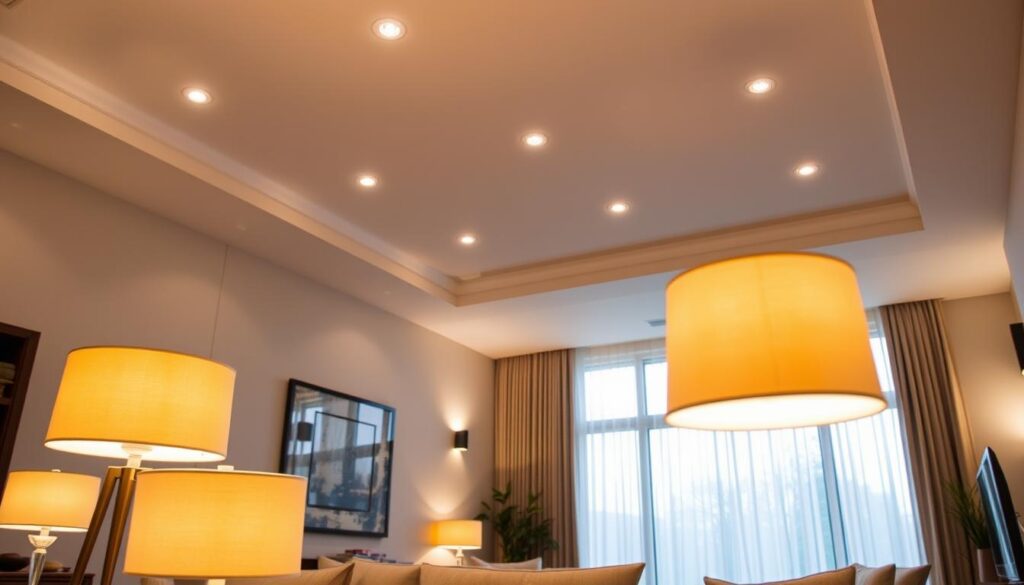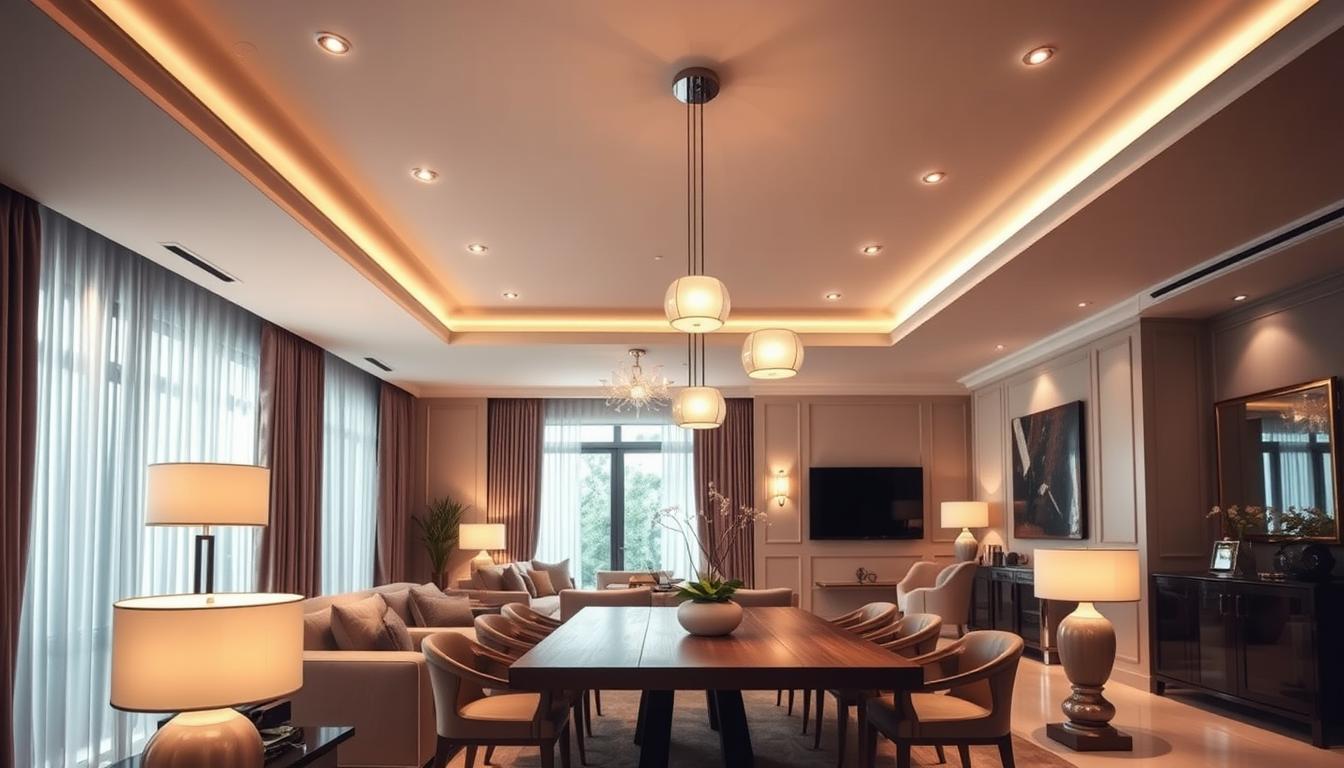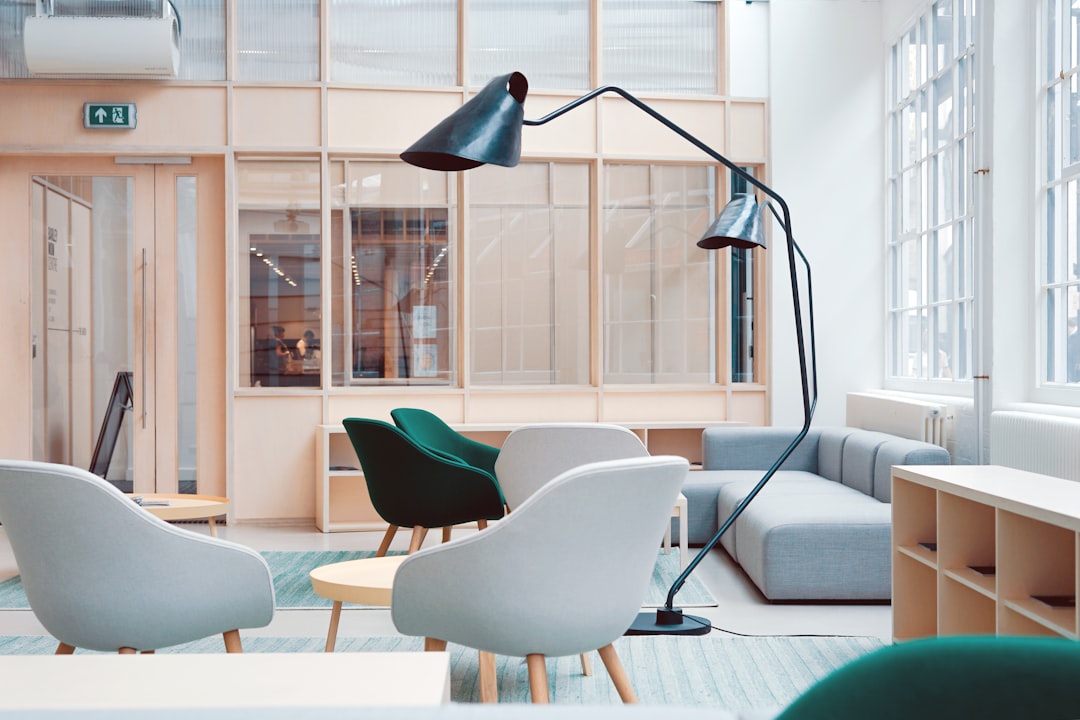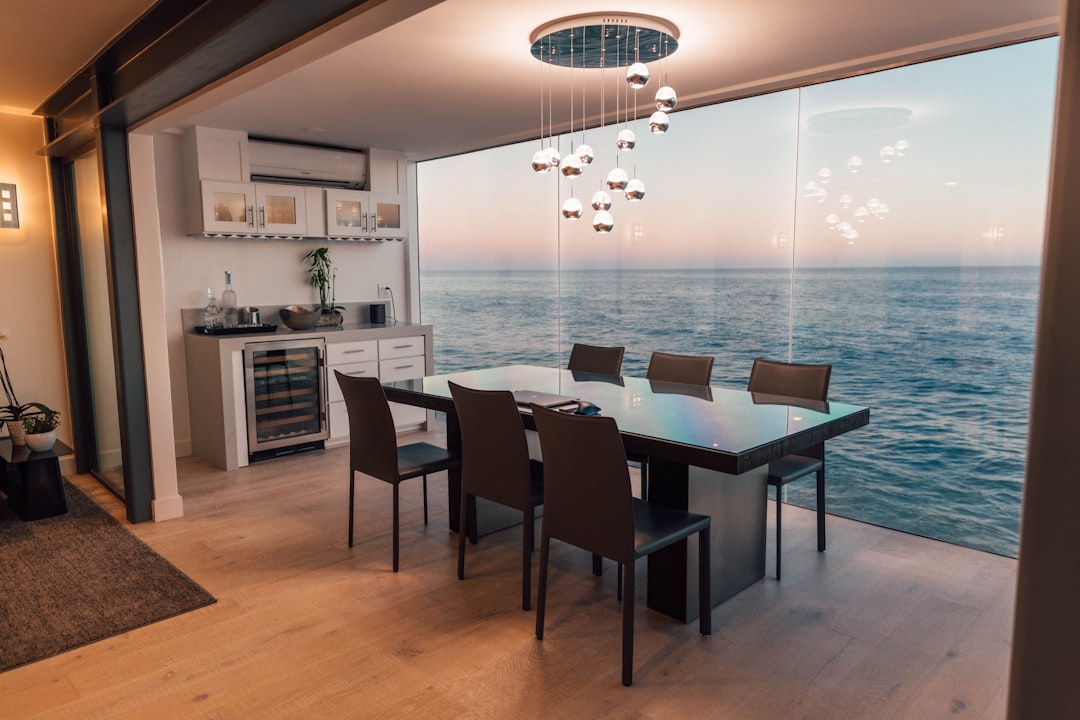Did you know that proper lighting can increase productivity by up to 20% and make a room feel welcoming? Good interior lighting solutions are key to a space that looks and feels great. Learning about residential lighting design is the first step to changing your home.
We’ll show you how to pick the best lighting fixtures and why lighting matters in design. Our guide will help you make smart choices for your home’s lighting. You’ll create a space that’s both stunning and useful.
Key Takeaways
- Understand the importance of lighting in interior design
- Learn how to choose the right lighting fixtures for your space
- Discover how to create a functional and beautiful living area
- Explore the principles of effective residential lighting design
- Gain insights into enhancing your home’s ambiance with lighting
Understanding the Importance of Lighting in Interiors
Lighting is key to making spaces beautiful and functional. It’s not just for seeing; it shapes the feel and use of a room.
Good lighting makes a space feel welcoming. It brings out the colors and textures of decor. It also affects mood and productivity.
The Role of Lighting in Interior Design
Lighting is crucial in interior design. It lights up spaces and adds visual interest. Modern lighting ideas use different lights for a layered effect, adding depth.
Designers mix light sources like overhead, table, and floor lamps. This creates a space that looks good and works well.
Enhancing Mood and Atmosphere
Lighting greatly affects a room’s mood and feel. Warm light makes a space cozy, while cool light energizes it.
The right lighting can change how colors look in a room. Designers pick lighting to make colors pop or calm down a space.
Functional vs. Aesthetic Lighting
Lighting is split into functional and aesthetic types. Functional lighting is for tasks like reading or cooking. Aesthetic lighting sets the mood and highlights decor.
| Lighting Type | Purpose | Examples |
|---|---|---|
| Functional | Task-oriented | Kitchen task lighting, reading lamps |
| Aesthetic | Ambiance and decoration | Accent lighting, decorative fixtures |
It’s important to balance functional and aesthetic lighting. Using a mix of interior lighting solutions and commercial lighting solutions creates a space that looks and works great.
Types of Lighting: An Overview
A good lighting plan has different layers of light. These include ambient, task, and accent lighting. This layered approach is key to residential lighting design. It makes spaces both functional and visually appealing.
Ambient Lighting
Ambient lighting is the base of a lighting plan. It gives a space overall light. It can be done with lighting fixtures for interiors like ceiling lights or recessed lights. Ambient lighting sets the mood of a space and makes it welcoming.
Task Lighting
Task lighting focuses on areas where you do tasks, like reading or cooking. It’s important for getting things done. You can use table lamps, under-cabinet lights, or desk lamps for task lighting. It makes a space both useful and stylish.
Accent Lighting
Accent lighting highlights special features in a space, like art or details. It adds depth and interest. By focusing on certain areas, accent lighting boosts a space’s look, making it a vital part of residential lighting design.
Choosing the Right Fixtures for Your Space
Choosing the right lighting fixtures is about more than just looks. It’s about style, size, and how energy-efficient they are. At Zara Interiors, we know how to mix beauty with function. This creates a space that feels welcoming and looks great.
Evaluating Style and Aesthetics
When picking lighting, we think about the room’s design. For example, modern lighting ideas are all about clean lines and simple designs. It’s key to pick fixtures that match your room’s look and your own style.
- Look at the room’s color and materials.
- Think about the furniture and room layout.
- Pick fixtures that add to the room’s look without taking over.
Size and Scale Considerations
The size of your lighting is very important. A big light in a small room can feel too much. A small light in a big room might not light it well enough. We suggest measuring your space and thinking about your furniture when picking lights.
- Measure your room’s size and ceiling.
- Look at the size of your furniture and other lights.
- Choose lights that fit well with your space.
Energy Efficiency and Bulb Types
Energy efficiency is a big deal when picking lights. We recommend LED bulbs because they save energy and last a long time. Knowing about different bulbs helps you make smart choices for your lighting.
- LED bulbs: Save energy and last long.
- Halogen bulbs: Give a warm light but use more energy.
- Smart bulbs: Have cool features like dimming and color changing.
By thinking about these things and working with a professional lighting design company like Zara Interiors, you can get a lighting design that’s both beautiful and useful.
Lighting Design Principles We Should Follow
To get a good lighting scheme, we need to follow some key principles. It’s not just about picking the right lights. It’s about making a space look good and work well.
Balance and Proportion
Lighting balance means spreading light evenly in a room. It’s important to mix light sources well to avoid too much contrast. Proportion means the size of lights fits the room and its furniture.
For balance and proportion, remember these tips:
- Think about the natural light and how it works with artificial light.
- Use different kinds of lighting (ambient, task, accent) for depth.
- Make sure lights are the right size for the room and its furniture.
Contrast and Harmony
Contrast in lighting makes a room interesting by changing light intensity and color. Harmony is about making all parts of the lighting work together. Good contrast and harmony make a room feel better.
To get contrast and harmony, try these:
- Change light intensity in different parts of the room.
- Use different light colors to set moods and highlight things.
- Make sure lights match the room’s style.
Layering Light Sources
Layering light means using many light sources to make a space look good and work well. This method makes a space more flexible and inviting. By mixing ambient, task, and accent lighting, we get a dynamic and welcoming space.
Layering light sources has many benefits:
- It lets us change lighting levels easily.
- It adds interest with different light sources.
- It makes a space more useful by lighting specific areas.
By using these lighting design rules, we can make spaces that are stylish, useful, and in harmony. These rules help whether it’s a home or a business, making sure the lighting is well thought out.
Incorporating Natural Light in Designs
Adding natural light to our designs is key for welcoming and green spaces. It cuts down on the need for man-made lights, saving energy. Plus, it boosts the health and work performance of those inside.
“Natural light is more than just light; it shapes a room’s feel,” says a top interior designer. By using more daylight, we make spaces that save energy and feel better for everyone.
Maximizing Daylight in Our Spaces
To get more daylight, we must think about the building’s direction and where windows go. Smartly placing windows and skylights lets in more natural light. For example, clerestory windows or skylights spread light deeper, cutting down on the need for artificial lights.
Window Treatments That Complement Lighting
Window treatments are key in managing natural light. Picking the right ones, like solar shades or curtains, lets in light but keeps glare and UV harm away. They improve the look and feel of a room.
For instance, solar shades cut down glare but still let in light. This boosts the room’s lighting and energy use.
The Benefits of Skylights and Open Spaces
Skylights and open areas bring natural light into our designs. Skylights light up dark spots from above. Open areas let light move freely, linking rooms together.
Using skylights and open areas makes spaces bright and attractive. Lighting pros say, “Skylights can cut artificial light use by up to 50%, making them key for saving energy.”
In short, adding natural light through daylight, smart window choices, and skylights makes our spaces better. It makes them functional and beautiful, improving everyone’s health and happiness.
Color Temperature and Its Impact on Design
The color temperature of lighting greatly affects the look and feel of our homes. As we explore Zara interiors lighting design, knowing about color temperature is key. It helps us make spaces that are welcoming and useful.
Understanding Warm and Cool Light
Lighting is divided into warm and cool light based on its color temperature, measured in Kelvin (K). Warm light, with a range of 2700K-3000K, gives off a cozy, yellowish glow. This is similar to the light from traditional incandescent bulbs. Cool light, from 3500K-5000K, is brighter and bluer, like modern LED lighting. The choice between warm and cool light changes a room’s ambiance a lot.
Choosing the Right Color Temperature for Each Room
Our homes have different rooms for different activities. The lighting color temperature should match each room’s purpose. Warm light is best for living rooms and bedrooms to relax. Cool light is better for kitchens and workspaces for tasks.
- Living Rooms & Bedrooms: Warm light (2700K-3000K) for relaxation.
- Kitchens & Workspaces: Cool light (3500K-5000K) for focus and efficiency.
How Color Affects Perception and Mood
The color temperature of lighting not only changes how a space looks but also how we feel. Warm lighting makes a room feel cozy and intimate. Cool lighting makes it feel bright and energized. Choosing the right color temperature improves both the look and feel of our homes, making them more stylish interior lighting designs.
| Room Type | Recommended Color Temperature | Effect on Ambiance |
|---|---|---|
| Living Room | Warm (2700K-3000K) | Cozy, Relaxing |
| Kitchen | Cool (3500K-5000K) | Bright, Energizing |
| Bedroom | Warm (2700K-3000K) | Intimate, Calming |
By understanding and using color temperature, we can create modern lighting ideas. These ideas not only light up our spaces but also make them look and work better.
Smart Lighting Solutions for Modern Spaces
Smart home technology has made lighting systems much better. They improve our homes and workplaces. Smart lighting brings together convenience, efficiency, and new designs.
The Benefits of Smart Technology
Smart lighting has many advantages. It saves energy and makes our spaces better. By using smart lighting, we can cut down on energy use and make our homes and offices greener.
Energy Efficiency: Smart lights adjust their brightness and turn off when not needed. This saves energy and money. It’s great for businesses, where lighting is a big energy user.
“Smart lighting is not just about saving energy; it’s about creating a more comfortable and productive environment.” – Expert in Residential Lighting Design
Popular Smart Lighting Brands
Many brands are at the forefront of smart lighting. Philips Hue, LIFX, and Belkin are among the most popular. They offer products for both homes and businesses.
- Philips Hue: Known for its wide range of smart light bulbs and innovative features.
- LIFX: Offers a variety of smart lighting products with advanced color control.
- Belkin: Provides smart lighting solutions that are easy to integrate with existing home automation systems.
Integration with Home Automation Systems
Smart lighting works well with home automation systems. This lets us control lights, temperature, security, and entertainment easily. It makes our homes fully connected.
Adding smart lighting to our homes improves our lives and saves energy. It also increases our property’s value.
The future of lighting is smart, and it’s here now.
Accent Lighting Techniques We Can Use
Accent lighting is an art that can make any room look better. By using the right techniques, we can make our space look good and show off our style.
Creating Focal Points with Light
Accent lighting helps make certain areas stand out in a room. This is done by using directional lighting fixtures to focus on specific spots or features.
- Spotlights can highlight a standout piece of furniture.
- Cozy reading nooks are created with floor lamps.
- LED strips under furniture add a modern touch.
Highlighting Artwork and Architectural Features
Accent lighting is great for showing off artwork and architectural details. With adjustable lighting fixtures, we can make sure these elements get the right light.
- Picture lights make artwork look like a gallery.
- Recessed lighting brings out architectural details.
- Wall washers give a uniform glow on textured surfaces.
Using Decorative Fixtures for Statement Lighting
Decorative lighting fixtures can be eye-catching on their own. At Zara Lighting Design Company, we have stylish lighting that can make any room better.
- Chandeliers or pendant lights can be the centerpiece in dining or living rooms.
- Table lamps with unique designs add character.
- Sconces with decorative elements enhance a room’s ambiance.
By using these accent lighting techniques, we can make our spaces both functional and beautiful. Whether it’s focusing on certain areas, highlighting art, or using decorative lights, the right lighting makes a big difference.
Budgeting for Your Lighting Design Project
A good budget is key to a successful lighting design project. It lets you reach your design goals without overspending. When setting your budget, think about both the upfront costs and ongoing expenses.
Cost-Effective Solutions Without Compromising Style
Finding affordable lighting solutions that still look great is a big challenge. Here are some ways to do it:
- Choose stylish, energy-saving fixtures to cut down on energy bills.
- Use multi-functional lighting to reduce the number of fixtures needed.
- Look for sales or last season’s models to save money without losing style.
Lighting design experts say, “A great lighting design is about more than just the fixtures. It’s about creating a welcoming space.” This approach makes your space look better and work better too.

Planning for Installation and Maintenance Costs
Installation and upkeep costs can add up. Here’s how to keep them down:
- Plan the installation to avoid extra electrical work.
- Choose easy-to-maintain fixtures to save on upkeep costs.
- Use LED bulbs for their long life and low replacement needs.
“A well-planned lighting design is not just pretty. It also saves money on energy and upkeep,” says a top professional lighting design services expert.
Exploring DIY vs. Professional Installation
You can install your lighting yourself or hire a pro. DIY is cheaper for simple jobs, but complex designs need a pro.
Choosing between DIY and a pro depends on the project’s complexity. Modern lighting ideas often need a pro’s skill to look and work right.
“Deciding between DIY and a pro depends on the project’s complexity and your comfort with the job. For most home lighting projects, hiring a pro is worth the extra cost for peace of mind.”
Sustainability in Lighting Design
Nowadays, we’re all more aware of the environment. This means we need sustainable lighting solutions more than ever. Lighting plays a big role in making our spaces more eco-friendly.
Eco-Friendly Lighting Choices
Choosing the right lighting can really help the planet. LED lighting is a top choice because it uses less energy than old-fashioned lights. Plus, LEDs don’t have harmful chemicals like mercury.
Using natural light is another smart move. By placing windows right and using mirrors, we can use less artificial light. This saves energy and helps the planet.
The Importance of Energy Efficiency
Energy efficiency is key in sustainable lighting. Picking lights that use less power helps the environment and saves money. Smart lighting systems are great because they adjust based on how many people are around and the light outside.
| Lighting Type | Energy Consumption | Environmental Impact |
|---|---|---|
| LED Lighting | Low | Minimal |
| Incandescent Lighting | High | Significant |
| Smart Lighting Systems | Variable, Optimized for Efficiency | Reduced |
Designing for Longevity and Minimal Waste
Designing lights that last a long time is also important. Choosing durable, timeless fixtures means we don’t have to replace them as often. This cuts down on waste. Also, thinking about whether lights can be recycled helps the environment even more.
As we keep improving lighting design, we must focus on being green. Making smart choices about our lighting can make our spaces beautiful and good for the planet.
Trends in Zara Interiors Lighting Design
Lighting design trends are always changing. At zara lighting design company, we’re always looking for new ideas. We want to inspire our designs with the latest stylish interior lighting.
Emerging Trends
Today’s modern lighting ideas mix technology and beauty. We see more smart lighting that’s not just efficient but also makes rooms feel cozy.
Want to add these trends to your home? Check out Zara’s retail interiors lighting design inspiration. It’s full of ideas for stylish, modern lighting.
Popular Styles
Popular styles include layered lighting and statement fixtures. Layered lighting creates a warm, inviting space. Statement fixtures add elegance to any room.



